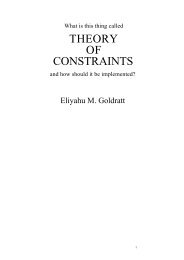Making of a German Constitution : a Slow Revolution
Making of a German Constitution : a Slow Revolution
Making of a German Constitution : a Slow Revolution
You also want an ePaper? Increase the reach of your titles
YUMPU automatically turns print PDFs into web optimized ePapers that Google loves.
150 • The <strong>Making</strong> <strong>of</strong> a <strong>German</strong> <strong>Constitution</strong>(1887) are important. 133 In the end, Goldschmidt headed the drafting commission forthe national Handelsgesetzbuch that was enacted in 1897 and introduced as a part<strong>of</strong> the new legal regime in 1900. 134 It was in commercial legislation, as Wieackerwrote, that ‘the special law <strong>of</strong> the entrepreneurial class in trade and industry’ wasinstituted in <strong>German</strong> society. 135 Indeed, special commercial courts were set up for theadjudication <strong>of</strong> commercial matters. The reason why industrial capitalism provedmore dynamic than agriculture, time and again, in the second half <strong>of</strong> the nineteenthcentury, was partly because it was helped along by friendly, commercial legislationand judicial arrangements.The Civil Code <strong>of</strong> SaxonyThe codification <strong>of</strong> civil law, like procedural and commercial law reform, was boundup with the broader political revision, which rested on a programme <strong>of</strong> constitutionaltransformation. Whereas procedural reform secured basic judicial rights and themeans to have these rights enforced, civil codes defined specific rights and obligations.The systems and codes that were produced after 1815 reflected the nationalistpolitical and social platform <strong>of</strong> Vormärz liberals, particularly that <strong>of</strong> the <strong>German</strong>ists.The Dresden Draft <strong>of</strong> Obligations Law, based on <strong>German</strong>ist theory, was cause forcelebration in liberal circles. 136 Draft civil codes were produced in Württemberg,Hesse and Bavaria between the 1850s and 1860s. These earlier state drafts wereimportant to the history <strong>of</strong> legal reform after unification, because the national codeswere modeled after the earlier state codes. While the Dresden Draft was never introduced,it was the model for the obligations law <strong>of</strong> the BGB. As a result <strong>of</strong> thistendency, private law <strong>of</strong>fers a window into the continuity <strong>of</strong> liberal development in<strong>German</strong> history.Saxony is where the drive for unified civil law had its greatest success prior tounification. Christian Ahcin <strong>of</strong>fers an informative study on the liberal politics thatstood behind the drafting <strong>of</strong> Saxony’s Civil Code. As he points out, a clear link tothe growth and impact <strong>of</strong> liberalism in Central Europe can be seen in the history <strong>of</strong>the Code. It had its roots in the early century and represented a culmination <strong>of</strong> thereformist movement that began after 1815. 137 Primarily, however, work on the Codewas a product <strong>of</strong> Saxony’s constitution, which had made it possible. 138 As Ahcinwrites, the first draft met with strident conservative criticism, which protested thatthe proposed draft <strong>of</strong> private law was the fruit <strong>of</strong> liberal agitation and a concessionto liberalism. 139 Major <strong>German</strong>ist figures such as Mittermaier, Arndt and Beselerweighed in favor <strong>of</strong> the draft and demanded that the content reflect <strong>German</strong> customarylaw. 140 No other piece <strong>of</strong> civil legislation shared the spotlight with Hanover’sProceßordnung as much as the Bürgerliche Gesetzbuch für das Königreich Sachsen<strong>of</strong> 1863 (BGBS). 141 Promulgated in 1863, it went into effect in 1865.




